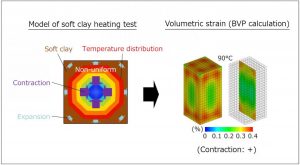
Credit: NITech
Unlike other geomaterials, soft clay can paradoxically contract upon heating. This phenomenon is termed the “volumetric contraction of soft clay due to heating.”
The thermodynamic behavior of geomaterials has received the increasing interest over the last two decades in the pursuit of understanding the effect of isotopic heating. Highly radioactive wastes are often buried in containers. Such containers are made from the absorbent clay bentonite mixed with other very stiff clays, as the integrity of which is essential for ensuring that these radioactive materials do not enter the ground, which would lead to a catastrophic environmental disaster. These containers and the surrounding geomaterials are exposed to the heat emitted from the waste materials, and this can continue for tens of thousands of years. This type of heating is impossible to replicate through field tests considering the massive timescale over which the heating occurs, making it imperative that accurate models are developed to predict the likely thermo-hydro-mechanical (THM) behaviors of clays.
Up until now, there has been an apparent incongruence between the observed behavior of clays when heated in the laboratory and the models used to describe this behavior. Heating tests have indicated that heat-induced changes in volume depend on the over-consolidation ratio (OCR) of the soils tested, with soft or consolidated clays tending to contract upon heating. However, the simple model that has been proposed to explain the behavior of soft sedimentary rock assumes that the geomaterial expands upon heating, regardless of its compaction level.
The researchers Feng Zhang and Yuhei Kurimoto at the Nagoya Institute of Technology (NITech) found new insights into the modeling of clays. They conducted a numerical simulation to reveal that a well-organized thermo-elastoplastic model can be used to accurately describe the phenomenon. They further confirmed that heating tests conducted by other investigators were not elementary tests but that they represented a Boundary Value Problem (BVP).Zhang and Kurimoto concluded that it is not necessary to include any additional parameters in the thermo-elastoplastic model to describe the volumetric contraction of soft clay due to heating, according to the universal rule that any materials will expand upon heating. “Because the heating test is a BVP, the phenomenon is simply an average behavior of the BVP and not an inherent property of the soil.” They stated also, “The proper modeling of the thermodynamic behavior of soft soils at elementary level will greatly increase the accuracy of the analysis on geoengineering problems related to thermal influence.”
In the current study, the researchers used a previously developed model to simulate heating tests of soft clay conducted in validated research. The analysis demonstrated that the previously conducted heating test was a BVP because of the existence of a non-uniform heating field. Further investigations at various heating stages illustrated that even with an extremely low heating rate, non-uniform thermal field within the heated sample will likely result in non-uniform stress and strain fields.
The heating process can be divided into the heat transfer and the water pore dissipation stages. As the thermal conductivity is much higher than hydraulic conductivity in soft clay, it results in rapid heat transfer compared to the rate of water pore dissipation. The analysis illustrated that because these processes do not occur consistently throughout the sample, the change in volume is non-uniform, resulting in contraction of the sample in some areas.
Reference:
Feng Zhang, Yuhei Kurimoto. How to model the contractive behavior of soil in a heating test. DOI: 10.1016/j.undsp.2016.05.001
Note: The above post is reprinted from materials provided by Nagoya Institute of Technology.










